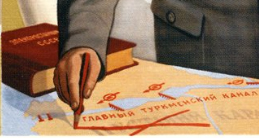
Viktor Govorkov (Говорков, В.), In the name of communism (во имя коммунизма), 1951
Stalin poster of the week is a weekly excursion into the fascinating world of propaganda posters of Iosif Stalin, leader of the USSR from 1929 until his death in 1953.
Here, Anita Pisch will showcase some of the most interesting Stalin posters, based on extensive research in the archives of the Russian State Library, and analyse what makes these images such successful propaganda.
Anita’s fully illustrated book, The personality cult of Stalin in Soviet posters, 1929 -1953, published by ANU Press, is available for free download here, and can also be purchased in hard copy from ANU Press.
Stalin and Lenin are juxtaposed as equals in Viktor Govorkov’s 1951 poster ‘In the name of communism’ which depicts the past and the present with realistic parallel scenes involving Lenin and Stalin.

Lenin displays a 1920 book outlining plans for the electrification of the Russian republic.
Both men are planning the electrification of the nation on a map. In Lenin’s left hand is a book titled Plan for the electrification of the RSFSR, 1920.
Lenin was always strongly associated with electricity in propaganda campaigns aiming to electrify the nation using the slogan ‘Communism is Soviet power plus the electrification of the whole country,’ which was originally a quotation from a 1930 speech by Lenin.
In the Soviet Union, lightbulbs were commonly referred to as ‘Ilich’s little lamps’ and Lenin was ceremonially thanked for delivering electricity to new communes.
During Stalin’s leadership, electrification remained strongly tied to Lenin, although Stalin was also associated with bringing power to the nation through massive industrial projects like the Dnieper Dam.

Stalin’s book outlines the plan for the electrification of the whole of the Soviet Union
In Govorkov’s poster, Stalin holds his unlit pipe and a newspaper with the headline ‘World Victory’ in his left arm. On the table lies a book titled Electrification of the SSSR and he is marking out the Main Turkmen Canal.
Thus, Stalin is seen to be continuing the work begun by Lenin. Lenin’s plan extends across the entire Russian republic, while Stalin’s encompasses the whole of the Soviet Union.

A greying Stalin looks back over 20 years of achievement
Building of the Main Turkmen Canal in Turkmenistan began in late 1950, but was halted in 1953 after Stalin’s death. It was replaced by the construction of the 1300km long Qaraqum Canal further south in 1954.
Anita Pisch‘s book, The personality cult of Stalin in Soviet posters, 1929 – 1953, is now available for free download through ANU Press open access, or to purchase in hard copy for $83. This lavishly illustrated book, featuring reproductions of over 130 posters, examines the way in which Stalin’s image in posters, symbolising the Bolshevik Party, the USSR state, and Bolshevik values and ideology, was used to create legitimacy for the Bolshevik government, to mobilise the population to make great sacrifices in order to industrialise and collectivise rapidly, and later to win the war, and to foster the development of a new type of Soviet person in a new utopian world.
Visit Anita Pisch’s website at www.anitapisch.com
